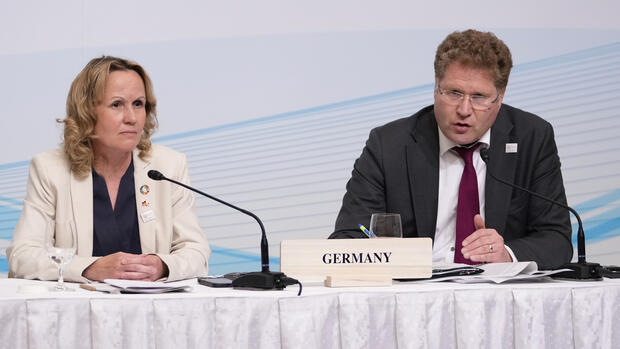Sapporo The environment and energy ministers of the G7 countries want to speed up climate and environmental protection. At their meeting in the Japanese metropolis of Sapporo on Sunday, the representatives of the seven leading industrial nations decided to reduce greenhouse gas emissions by 60 percent by 2035.
One means of doing this is the increased expansion of renewable energies. By 2030, the alliance wants to set up additional wind turbines with an output of more than 150 gigawatts and solar systems with more than one terawatt. The planned new wind turbines will have an output of about 150 nuclear power plants. The G7 also want to stop plastic pollution by 2040. So far, this goal should only be reached in 2050.
However, there were also disappointments at the meeting of environment ministers. A complete shift away from fossil fuels is not in sight when it comes to creating a climate-neutral economy by 2050. Japan’s Economics Minister Yasutoshi Nishimura made it clear that the states had agreed on “different paths” to the common goal.
Japan enforces its priorities
The joint communiqué, which has been drawn up since Saturday under the Japanese presidency, comprises a total of 36 pages. Federal Environment Minister Steffi Lemke called the result “ambitious and holistic”. The resolutions are “an important signal” in times of crisis that the G7 are moving forward as one.
Patrick Graichen, who represented the German Ministry of Economic Affairs as State Secretary, also considered it a “great success” that the G7 were able to agree on quantitative targets on some points for the first time. He emphasized that the planned new solar systems exceeded the one terawatt mark for the first time.
When it comes to the use of nuclear power and fossil fuels, however, the strategies diverge further. While Germany switched off its last nuclear reactor over the weekend, most other G7 members continue to rely on nuclear power. Host Japan is also promoting the use of gas and coal, the exhaust gases from which carbon dioxide is extracted.
>> Read here: Why Japan is a role model for Scholz when it comes to the security of raw materials
The communiqué took this into account: the G7 pledged to accelerate the use of untreated fossil fuels by 2050 “to achieve net-zero energy supply by 2050 at the latest”. The G7 called on other countries to “join us and take the same action”.
This also addressed a point that is important to Japan: the government of the world’s third-largest economy is committed to using hydrogen and, in particular, its derivative, toxic ammonia, as a fuel in power plants. The G7 now agreed to this “if this is compatible with the path to limiting global warming to 1.5 degrees and our common goal of full or extensive decarbonisation of the energy sector by 2035”.
The G7 also want to intensify cooperation with the “Global South”, i.e. the developing and emerging countries. Japan wants to take the lead in Asia, Economy Minister Nishimura said, especially in the gas sector. The aim is to increase investments in gas production in order to avoid global gas bottlenecks.
Gas will remain an important source of energy in Asia
Additional gas production is not only important in Europe in order to become independent of coal and the previous Russian gas sources. In the boom region of Asia in particular, natural gas will have to replace coal in order to successfully reduce greenhouse gas emissions.
The Association of Gas Producing Countries estimates that gas requirements in the countries of the Southeast Asian community of states ASEAN will increase by 120 percent to 350 billion cubic meters by 2050. Japan therefore founded the Asia Zero Emission Community (Azec) to help countries finance new power plants and carbon capture systems. Japan wants to play a leading role, Economy Minister Nishimura said at an Azec meeting in early March.
Nishimura suggested at the time that members, which include Australia, might consider creating a master plan for hydrogen and ammonia in Asia as a next step.
At the same time as the meeting of environment ministers ended, the G7 foreign ministers’ meeting started in Karuizawa, Japan. In the afternoon, the foreign ministers traveled together in the Japanese high-speed Shinkansen train from Tokyo to the holiday resort, where the meeting began with the traditional “family photo”. A joint dinner is planned for Sunday evening.
Most talks take place on Mondays. It will mainly be about the Ukraine war, but also a lot about China. German Foreign Minister Annalena Baerbock was in the People’s Republic for talks until Saturday. One of the topics is likely to be the conflict in the South China Sea – including Taiwan. Japan, which holds the presidency of this year’s G7 meetings, is deeply concerned about China’s increasing military drills in the South China Sea.
More: Baerbock’s clear words are correct – Germany must come to terms with China
